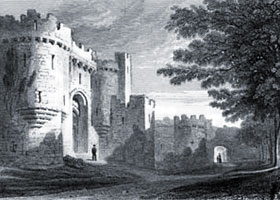Beaumaris CastleKey facts and Information about Beaumaris Castle - The location of Beaumaris Castle - Isle of Anglesey, North Wales
- The building of Beaumaris Castle started in 1295
- Building at Beaumaris Castle stopped in 1320, it was never fully completed due to lack of funds
- The Architecture / Style - Gothic Architecture aka Edwardian
- The cost of building Beaumaris Castle - £14,400
The Building of Beaumaris Castle
The history of the building of Beaumaris Castle is fascinating. In just a relatively short period of time a significant number of new Welsh Medieval Castles were built or modernised under the instructions of King Edward I (1272-1307) including Beaumaris Castle. King Edward employed the services of an architect and master builder called Master James of St George to carry out many of these ambitious plans for a chain of Medieval castles to be built in Wales. Beaumaris Castle was built in North Wales to control the Menai Straights between the Welsh mainland and the Isle of Anglesey. An important feature of Beaumaris Castle is its access to the sea. During the construction of Beaumaris Castle men, equipment and building materials were easily transported by boats to the site of the castle. Once Beaumaris Castle was built fresh supplies, provisions and reinforcements prevented the castle occupants from being starved into submission during siege warfare. The advantages of swift and easy accessibility via the sea ensured that the new fortified town, which was built at the same time as the castle, became a successful and prosperous stronghold for its English inhabitants. Beaumaris - A Concentric Castle Design
Welsh Castles including Beaumaris Castle, built by Edward I, are referred to as Concentric Castles. The Gothic architecture of the Medieval era together with the design of Concentric Castles encompassed some, or all, of the following elements: - A Stronger central Keep or Main Tower
- A Round or Circular Shaped Keep
- A High wall, complete with towers surrounded the Keep and the Inner Bailey
- At least one lower, outer wall surrounded the Inner High Wall
- Several Outer Walls and Outer Baileys were often added!
- Several Gatehouses were featured
- Moats were added which surrounded the whole Concentric Castle complex
Concentric castles were bigger than any previous castles! The walls were thicker, stronger and higher with turrets! The Inner Walls were higher than Outer walls! Drawbridges were added! The interiors were more comfortable, even luxurious! Concentric Castles, like Beaumaris, were very expensive! |

